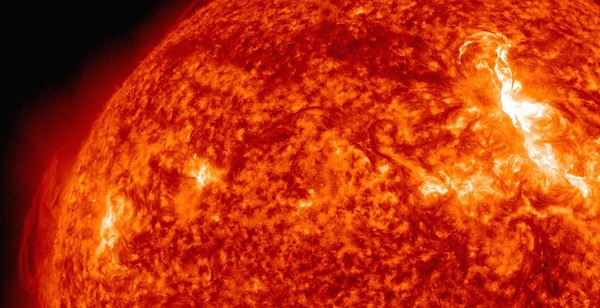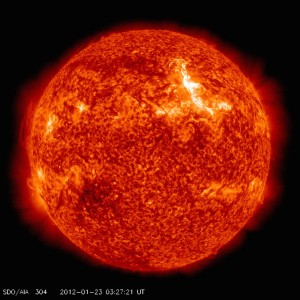Solar Storms a Wake-Up Call, Redfield Says


A July NASA report that a huge solar storm narrowly missed Earth in 2012 – avoiding catastrophic damage to energy, transportation and communications systems – has caused a media stir and some worry among Earthlings.
What’s more, other recent reports say that Earth is overdue for a devastating storm of the kind known as a “Carrington event” after an 1859 storm that disrupted telegraph signals and caused other damage in a still-nascent industrial world. Named for 19th-century English astronomer Richard Carrington, it was the largest of its kind on record. A similar event now, in a world dependent on digital communications and electrical energy, would cause widespread, long-lasting power outages and disrupt transportation and communications planet-wide. Eric Mack, a science blogger for Forbes, referred facetiously to a reversion to “Amish-style” civilization.
Seth Redfield, assistant professor of astronomy, says the recent near-miss isn’t a cause for worldwide freakout, but should be a wake-up call; while a catastrophic solar storm may be several generations away, “it’s going to happen,” and scientists should be working on ways to better predict the event.
“I think it’s really important for us to understand what’s going on and have some good perspective on that because if we don’t prepare for it, we’re going to suffer the consequences,” he said. “We don’t need a Manhattan-style project and (to) devote 10 percent of our GDP to this one. But we do need to pay attention.”
Redfield said solar storms happen when violent eruptions on the surface of the Sun eject enormous bubbles of plasma and energy. Typically, charged particles from these eruptions are pulled toward the Earth’s two poles. The aurora borealis, or Northern Lights, are evidence of this fairly common occurrence.
But what happens if the particles don’t pull Pole-ward, but aim directly at the equator?
“Auroras are beautiful, but they have a darker side,” Redfield said. “The same charged particles that create the aurora can alter the magnetic field around the Earth. If they hit our satellites, it could destroy them, could fry the electronics.” At the least, that that could mean an end to long-range satellite weather forecasts, including the ability to predict violent weather such as hurricanes or blizzards. And that’s just the tip of the iceberg: Charged particles could also destroy military and communications satellites and ruin high-voltage equipment. Had the 2012 storm been a direct hit, life on Earth wouldn’t be wiped out, but our 21st century existence would have been considerably more difficult for some time.
“One worst-case scenario is that a third of the country has no electrical power,” Redfield said. “Or imagine going a couple seasons without having (the satellite images that provide) warning about hurricanes.” While Doppler radar might still work, the space-based images we are used to seeing on the weather reports would disappear. Everyday electrical devices might be useless, he said, citing a lower-level solar storm in 1989 that left Quebec powerless for a week.

“Life as we know it wouldn’t have been altered for all time, and it’s easy to be dramatic, but this would have been pretty major,” he said.
NASA and its counterparts around the world monitor “space weather” to stay on top of solar activity and other things that could affect satellites, other spacecraft and astronauts. But more needs to be done to give Earth more than “between 10 to 20 minutes to a few days of warning” before a big solar storm, Redfield said.
“We’re good at short-term problems. Long-term concerns are just not a priority with us,” he remarked. “Solar storm research – just like asteroid research – suffers from the very low likelihood of these things occurring in our lifetimes.”
In other words, out of sight, out of mind. But what about generating panic with reports of serious danger? “Astronomy is almost solely dependent on taxpayer dollars. That means a lot of our stuff is funded by people to whom we have an obligation to communicate back,” he said. “Still, there’s a danger there to exaggerate every finding – scores of papers are published every two weeks and there’s a risk of crying wolf.”
Redfield’s own research takes him quite close, in relative terms, to the Sun. His current work on the interstellar medium involves observing two nearby stars that are in the same direction as the Voyager spacecraft, which has recently ventured out “beyond the environment of the sun,” into the vastness of space.

